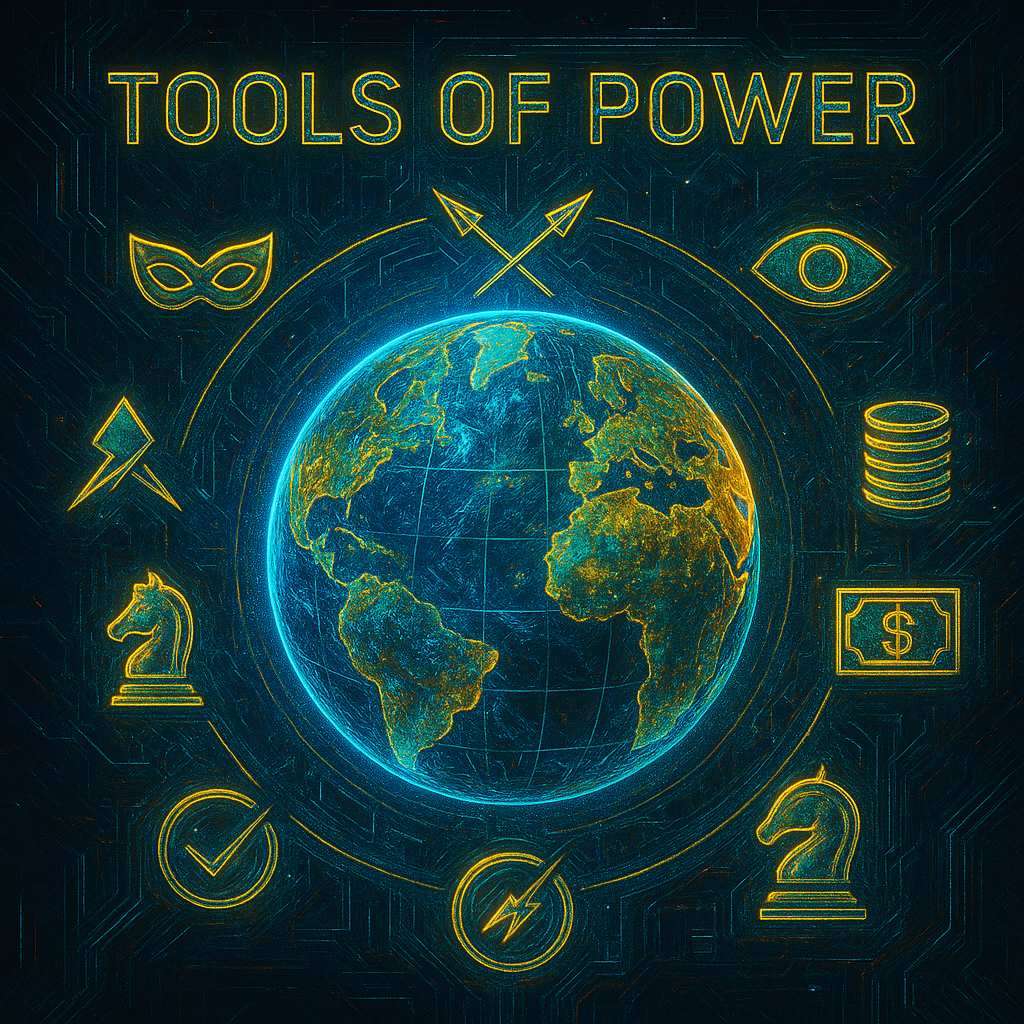Tools of Power

Power is the hidden skeleton of civilization. It is not inherently good or evil; it is neutral, like electricity, waiting to be harnessed. Depending on who holds it and how it is structured, power can illuminate entire societies or burn them to ash. To understand power is to understand how history has unfolded, how the present operates, and how the future is being engineered. The same tools appear again and again — control of perception, division, the cloak of virtue, capital, data, attention, invisible levers, and the architecture of incentives. These tools are not bound to morality. They are instruments, and like instruments, they can play symphonies or dirges.
Perception as the Terrain
The first tool of power is perception. Whoever controls the lens through which events are interpreted controls the meaning of those events. Armies conquer land, but narratives conquer minds.
In the past, Rome produced official chronicles that framed conquests as destiny. Columbus “discovered” the Americas not in fact, but in narrative, by renaming lands and embedding them into Europe’s story. In the present, perception still dictates outcomes. A single image of a drowned Syrian child in 2015 shifted refugee debates in Europe more than a thousand reports. On TikTok or X, the framing of a trend often matters more than the facts beneath it. In the future, perception will be engineered at machine speed. Synthetic satellite imagery, AI-generated “eyewitness” accounts, and fabricated sensor logs will overwhelm truth. Reality itself will be contested terrain, with the first frame to arrive often becoming the permanent one.
- Past examples: Rome’s official histories, colonial maps.
- Present examples: Social media virality setting agendas, satellite imagery defining “truth.”
- Future examples: AI-generated realities saturating public belief.
Division as a Strategy
The second tool of power is division. A fragmented opposition cannot threaten the center, and division is not accidental — it is cultivated.
Colonial powers perfected this strategy, arming rival tribes and ruling through intermediaries. Divide et impera was Rome’s most enduring political technology. Today, digital platforms fragment societies more effectively than any governor or general ever could. Algorithms that maximize engagement elevate outrage, turning communities into hostile tribes. In Myanmar, Facebook narratives ignited ethnic cleansing. In the United States, Russian troll farms simultaneously ran pro-Black Lives Matter and pro-police pages to amplify polarization. The future will push this even further. AI-personalized feeds will create micro-tribes — millions of miniature realities where solidarity is impossible because every individual is radicalized differently. Division does not merely weaken resistance; it creates permanent distraction.
- Past examples: Colonial divide-and-rule.
- Present examples: Algorithmic outrage fueling polarization.
- Future examples: AI-driven micro-tribes fracturing solidarity.
The Cloak of Virtue
The third tool of power is virtue. Raw coercion provokes resistance, but cloaking domination in moral language disarms it. People resist tyrants but embrace saviors.
History is filled with rulers who claimed morality to justify power. Monarchs ruled by divine right. Colonization was packaged as civilizing. Today, surveillance is sold as safety, monopolies as innovation, austerity as responsibility. Philanthropy operates as soft power, funding universities, NGOs, and research that later shape global policy pipelines. In the future, planetary AI governance may be wrapped in the language of fairness and justice, while encoding bias and hierarchy into its systems. The most effective chains feel like gifts, not shackles.
- Past examples: Divine right, “civilizing missions.”
- Present examples: Patriot Act as “safety,” philanthropy as global governance.
- Future examples: AI rule disguised as fairness and inclusion.
The Flows of Capital, Data, and Attention
The fourth tool of power is control of flows. Capital builds the skeleton, data forms the nervous system, and attention is the blood that animates it all.
In the age of empire, gold and silver sustained armies while telegraph cables transmitted intelligence faster than soldiers could march. In the present, BlackRock and Vanguard hold trillions of dollars and exert invisible influence by voting on corporate boards. Data brokers compile intimate portraits of billions of people, predicting and manipulating behavior. Attention flows create real-world cascades: a rumor about a bank can spark an actual run, a viral video can topple governments. In the future, whoever integrates finance, sensors, and real-time feeds will hold planetary control. Power will not just govern money and information; it will govern belief itself.
- Past examples: Gold and telegraphs.
- Present examples: Global finance giants, data brokers, viral cascades.
- Future examples: AI-governed integration of finance, sensors, and feeds.
Every Tool Is Turned
The fifth tool of power is inevitability. Every liberating technology eventually becomes a weapon. Liberation is temporary; co-optation is the rule.
The printing press freed scripture, then states censored it. Radio connected citizens, then became the voice of propaganda. Television carried dissent, then became curated narrative. The internet began as freedom, then consolidated into surveillance capitalism. AI starts as open research but is rapidly closing into proprietary systems that automate manipulation. Tools themselves are neutral; it is always power that bends them.
- Past examples: Printing press, radio propaganda.
- Present examples: Internet surveillance, crypto oligopolies.
- Future examples: AI co-opted for automated narrative control.
Invisible Levers
The sixth tool of power is invisibility. The unseen hand moves the heaviest stones.
Royal secrets and dynastic blackmail once determined the fate of nations. Today, kompromat quietly disciplines leaders. Search engines bury stories. Algorithms throttle dissent invisibly. Supply chains hide vulnerabilities — Taiwan’s semiconductor dominance or China’s rare earth monopoly can cripple industries overnight. Soft networks of universities, accreditation boards, and NGOs shape how entire generations think. Tomorrow, AI recommendation systems and proprietary risk models will regulate beliefs, economies, and politics invisibly.
- Past examples: Dynastic blackmail and hidden secrets.
- Present examples: Jeffrey Epstein, Search throttling, supply-chain chokepoints.
- Future examples: AI systems dictating belief and risk.
Incentives, Not Conspiracies
The seventh tool of power is alignment. Incentives outperform conspiracies because shared interests naturally converge behavior.
Monarchs taxed peasants because tribute was survival. Trade cartels emerged because profit demanded it. Social platforms amplify outrage because outrage maximizes revenue. Politicians legislate for donors because donations win elections. In the future, AI will polarize automatically if polarization maximizes engagement. Conspiracies are optional; incentives are enough.
- Past examples: Monarchs and tribute, trade cartels.
- Present examples: Outrage algorithms, donor-driven politics.
- Future examples: AI agents polarizing by default for revenue.
Strategy Over Force
The eighth tool of power is subtlety. Strategy defeats strength because it shapes the field before conflict even begins.
Empires that lasted, like Britain’s in India, relied on co-opting elites rather than brute force. The Cold War was decided as much by culture, economics, and media as by nuclear arsenals. In the present, a single viral photo can shift global migration policy, while an insurer withdrawing coverage can cripple a supply chain. In the future, infrastructure defaults and AI-driven disinformation may decide wars before armies move.
- Past examples: British India, Cold War soft power.
- Present examples: Viral images, insurance withdrawals.
- Future examples: AI disinformation paralyzing armies.
The Future as Fog
The ninth tool of power is confusion. Truth itself is becoming probabilistic, never absolute.
Propaganda leaflets confused soldiers in World War I and II. Competing Cold War narratives created parallel “realities.” Today, conspiracy networks online already live in separate realities, each convinced the others are insane. In the future, synthetic media will saturate every perception channel. Deepfake eyewitnesses, fabricated sensor logs, and synthetic satellite imagery will create permanent fog. Societies will live in parallel worlds, irreconcilable in their truths.
- Past examples: Propaganda leaflets, Cold War narratives.
- Present examples: Online conspiracy communities.
- Future examples: AI-generated realities dominating perception.
Power as Neutral, Good and Evil as Fields
The tenth and final tool of power is neutrality. Power itself is neither good nor evil; it simply amplifies intent. Good and evil are not groups but forces, more like electromagnetic fields running through human systems.
Under certain conditions, the evil frequency resonates: deception, exploitation, cruelty, domination. Under other conditions, the good frequency amplifies: cooperation, empathy, resilience, truth. Both are always present, colliding, interfering, and amplifying across societies. Evil is not merely dictators or corporations; it is a current that flows when structures align for harm. Good is not simply saints or protests; it is a wave that emerges when conditions favor justice and compassion.
The task is not to demonize tools or endlessly chase villains but to redesign the field itself. Build incentives, infrastructures, and norms that dampen evil’s frequency and amplify good.




